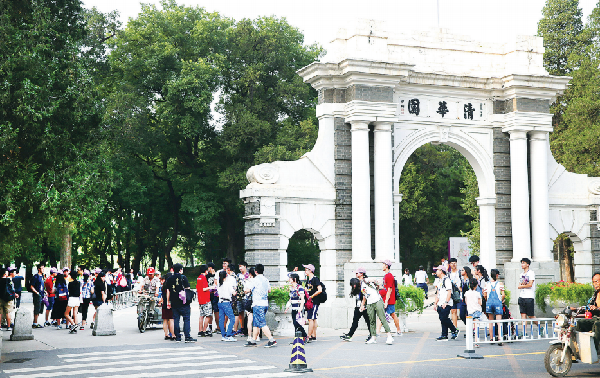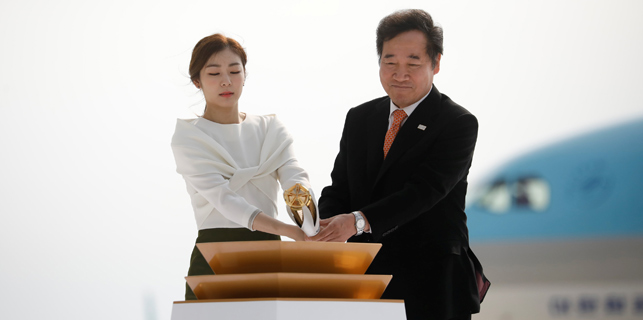Universities make grade
 |
|
Pedestrians walk past the gates of Tsinghua University in Beijing. The elite university has produced many successful people in politics, academia and industry. IMAGINECHINA |
China's emphasis on higher education pays off as its institutions rise in world rankings to compete with global elites
For the first time, Peking and Tsinghua universities, two of the Chinese main-land's most prestigious centers for higher education, have entered the top 30 in the respected Times Higher Education World University Rankings.
"The rise of China in this year's table is remarkable and demonstrates the way the global higher education landscape is changing," said Phil Baty, editorial director for global rankings at Times Higher Education.
He added that other East Asian nations will need to work hard to stay competitive as China "soars to join the global elite".
"Our rankings show China's higher education improvement is real and growing."
Founded in 2004, the annual analysis now features a total of 1,000 institutions — compared to just 200 when it first published.
China's leading universities are "truly now part of the global elite and overtaking prestigious universities in the United States, United Kingdom and Europe", according to Baty.
A source at Peking University said it is moving toward becoming "a great university" and a combination of factors have contributed to its climb in the global rankings.
The rise of higher education in China has been driven by a large investment in science and technology subjects as the country transitions from a manufacturing economy to one built on technology, research and innovation.
"Chinese universities are doing out-standing work in science, technology, mathematics and life sciences," Baty said. "What China needs to do now is to strengthen its arts and humanities and social sciences programs."
Arts and humanities subjects are very important to create the balance and to provide the creativity needed to push research to the next level, he said. "So that's the challenge. Another challenge is perhaps to be even more international."
The strong showing in the rankings is testament to the emphasis China has placed on higher education. Just a few years ago, the Chinese mainland had two universities in the top 200. Last year it had four, and this year seven.
Francisco Marmolejo, lead tertiary education specialist with the World Bank, said that while China's rise in the rankings is impressive, it is "important to remember China has the largest higher education system in the world".
"China's global share of enrollment as well as the number of higher education institutions are of such magnitude that it shouldn't be a surprise to have some of its institutions become globally prestigious."
Marmolejo said that China has significantly invested in expanding and improving its higher education system in recent years.
"A key part of the Chinese strategy has been the government's conscious decision to support a select number of universities to develop their capacity and infrastructure with the concrete goal of climbing into the global rankings," he said.
"Another factor that should be taken into consideration is that many universities all over the world — and China is no exception — have become more sophisticated in response to the indicators of excellence being defined by rankers and, consequently, have established concrete mechanisms to constantly monitor their performance."
Higher education has been a priority in China for more than two decades, with various projects initiated in the 1990s to create elite centers of learning.
In 1995, Project 211 was launched to raise the research standards of China's top universities. Institutions that reach a certain standard were rewarded with significantly increased funds. Today there are 116 higher education institutions that are part of this project.
Project 985 was established three years later and uses a similar strategy, although just 39 universities have received sponsorship as a result of this. In 2011, it was announced that no new universities would be admit-ted to this exclusive group.
The final and most select group is the C9 League, a grouping of the country's top nine elite universities who between them receive 10 per-cent of China's national research budget.
Peking University is a member of the C9 League and is generally one of the highest ranked institutions in China. Founded in 1898, it was the first modern national university in China.
Located in Haidian district in northwest Beijing, it is home to some of the capital's most prominent and recognized gardens and traditional architecture.
The university has established joint degree programs with a number of foreign universities, including Cornell and Yale in the United States; the London School of Economics and Political Science; the Paris School of International Affairs; Waseda University; and the University of Tokyo.
Tsinghua University, established in 1911, is also located in Haidian district. Like Peking University, it retains much of its traditional architecture, juxtaposed with many buildings built in the Western style reflecting the historical American influence on the campus.
Tsinghua University is a comprehensive research university. Its 20 schools and 54 departments cover disciplines in art, economics, education, engineering, history, management, medicine, law, literature, philosophy and sciences.
Many successful people in politics, academia and industry have graduated from Tsinghua University, including two Nobel Prize winners, Tsung-Dao Lee and Chen-Ning Yang. They won the 1957 prize in physics for their work on parity laws.
The government has invested heavily in higher education and has given universities more autonomy to accelerate growth.
The country's 13th Five-Year Plan (2016-20) outlined a renewed commitment to the quality of Chinese higher education, with a focus on making graduates employable and encouraging entrepreneurial skills.
John Mortensen, China regional director of education services at the professional services, real estate and investment management firm Jones Lang LaSalle, said the Chinese government has acknowledged that it needs to allow greater freedom in the sector.
"In order to make the universities more competitive and innovative, the government is now reviewing some of the traditional constraints and giving more autonomy over aspects such as leadership and how funding is applied in research," he said in a recent paper.
"This new openness will bring Chinese universities more in step with their global competitors and partners."
Mortensen said China's growing prominence in the field of higher education only reinforces what economists and business leaders have been saying. "Given China's importance as a major trading hub, it is naturally advantageous for foreign students to study in the country," he said.
Once considered an exporter of international students, China is reversing the trend, as it hopes to increase its share of international student numbers, which have expanded at 7 percent every year over the last decade, according to the Organization for Economic Cooperation and Development.
This is creating a stir in more traditional receiving destinations like New Zealand and Australia.
"Previously, China was trying to understand the world in which it was just beginning to do business," said Mortensen.
"Now it has become imperative for the rest of the world to understand China, which is the second-biggest recipient of direct investment world-wide, after the US. More countries are sending students over to China to study the Chinese ways of doing business."
karlwilson@chinadailyapac.com









